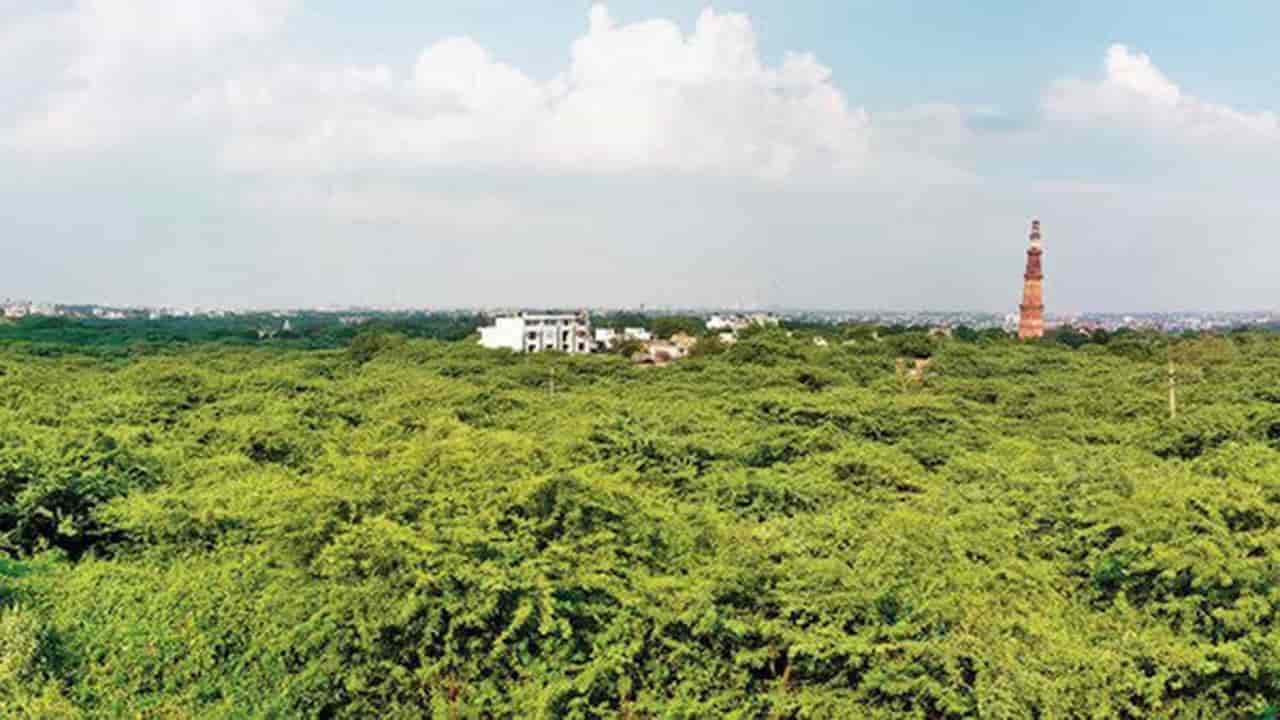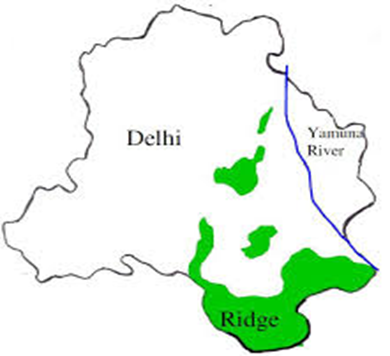- Courses
- GS Full Course 1 Year
- GS Full Course 2 Year
- GS Full Course 3 Year
- GS Full Course Till Selection
- Online Program
- GS Recorded Course
- NCERT (Recorded 500+ Hours)
- Polity Recorded Course
- Geography Recorded Course
- Economy Recorded Course
- AMAC Recorded Course
- Modern India, Post Independence & World History
- Environment Recoded Course
- Governance Recoded Course
- Science & Tech. Recoded Course
- International Relations and Internal Security Recorded Course
- Disaster Management Module Course
- Ethics Recoded Course
- Essay Recoded Course
- Current Affairs Recoded Course
- CSAT
- 5 LAYERED ARJUNA Mentorship
- Public Administration Optional
- ABOUT US
- OUR TOPPERS
- TEST SERIES
- FREE STUDY MATERIAL
- VIDEOS
- CONTACT US
Supreme Court Action On Delhi Morphological Ridge Violation
Supreme Court Action On Delhi Morphological Ridge Violation

1 What is the case?
The Supreme Court has issued show cause notices to senior Delhi government officials for violations in Delhi’s first private housing project on fragile Ridge land.


1.2 BACKGROUNDER
- About Delhi Morphological Ridge:
- The Delhi Ridge is the northernmost extension of the Aravalli Hills, a mountain range that spans Rajasthan, Haryana, and parts of Delhi. The Ridge consists of rocky outcrops of ancient quartzite and is considered one of the oldest surviving mountain systems in the world, dating back over 1.5 billion years.
- The Aravalli Range formed due to the orogenic process of folding during the Proterozoic era. This folding was a result of tectonic plate movement, specifically when tectonic plates collided and pushed upward, causing the earth's crust to crumple and form mountain ranges.
- Delhi ridge stretches approximately 35 kilometers from mahipalpur in the southwest to wazirabad in the northeast Delhi
- Four Zones of the Ridge:
- Northern Ridge: Located around Delhi University and Civil Lines area.
- Central Ridge: Spans areas near Sardar Patel Marg and Presidential Estate.
- South-Central Ridge: Covers portions of Mehrauli and Vasant Kunj.
- Southern Ridge: Includes Asola Bhatti Wildlife Sanctuary and adjoining forests.
- Legal and Institutional Backing
- The 1996 Supreme Court ruling in M.C. Mehta vs. Union of India laid down crucial safeguards for ecologically sensitive areas such as the Delhi Ridge and its morphological extensions. Through this directive, the Court:
- Prohibited any encroachment or diversion of land for non-forest use without prior approval from the judiciary.
- Mandated that proposals for land-use change within the Ridge must be vetted by both the Ridge Management Board (RMB) and the Central Empowered Committee (CEC).
- Although the Ridge has not been formally notified as a Reserved Forest under the Indian Forest Act, 1927, it receives substantial legal protection under judicial directives and environmental jurisprudence.
1.3 Importance of Delhi morphological ridge
- Ecological Importance: The Morphological Ridge plays a critical role in maintaining Delhi’s ecological balance. The area is characterized by:
- Rocky outcrops and shallow soils.
- Dry thorn forests with drought-resistant plant species like bistendu and dhak.
- Uncultivable rocky hills, often referred to as gair mumkin pahad in revenue records.
These features contribute to the Ridge's role as a natural green lung for Delhi, helping to:
- Absorb pollutants and reduce air pollution.
- Prevent desertification and mitigate the effects of sandstorms.
- Provide a habitat for native flora and fauna, contributing to biodiversity.
- Geological and Mineral Significance:
- The Ridge exposes some of the oldest rock formations in the Indian subcontinent, offering important geological insights and academic value for earth sciences.
- the Ridge contains quartzite and other valuable minerals, mining is strictly prohibited due to its protected status and ecological sensitivity.
- Cultural, Heritage & Recreational Role: The Ridge houses many monuments which reflect Delhi’s medieval history and Indo-Islamic architecture:
- Qila Rai Pithora
- Tughlaqabad Fort
- Bhuli Bhatiyari Ka Mahal
- Public Recreation & Eco-tourism: Trails and biodiversity parks (e.g., Aravalli Biodiversity Park, Sanjay Van) serve as eco-tourism and recreational hubs for nature walks, birdwatching, and education.
- Urban Buffer and Zoning: The Ridge acts as a green buffer zone, limiting urban expansion and protecting surrounding neighbourhoods from air, noise, and visual pollution. By supporting vegetation and drainage, the Ridge helps reduce the risk of floods and soil erosion.
1.4 Issues Faced by the Delhi Morphological Ridge
- Encroachment and Illegal Construction:
According to a 2019 affidavit submitted by the Delhi Forest Department to the Supreme Court, over 600 encroachments were identified across various Ridge zones. For example, in the Southern Ridge (Asola-Bhatti area), large farmhouses and banquet halls have sprung up in violation of Ridge conservation norms. - Weak Enforcement of Regulations:
The CAG Report 2022 flagged lapses in inter-departmental coordination and poor enforcement by land-owning agencies like DDA and the Delhi Forest Department. - Lack of Clear Demarcation:
A 2021 submission to the Delhi High Court admitted that official boundary maps are still being updated, leading to confusion over protected versus unprotected zones.
- Invasive Species and Ecological Degradation:
Prosopis juliflora, an invasive species, covers nearly 90% of vegetated areas in the Southern Ridge, choking native flora like dhak (Butea monosperma) and bistendu (Anogeissus pendula), reducing biodiversity and soil fertility. (Delhi Biodiversity Foundation study (2018)) - Fragmentation of Ridge Zones:
Infrastructure projects like the Chirag Delhi flyover and Mehrauli-Gurgaon Road widening have dissected the Ridge into isolated patches, breaking wildlife corridors. This fragmentation has resulted in declining populations of reptiles and small mammals. - Pollution and Waste Dumping:
The North Ridge (near Kamla Nehru Ridge) has seen repeated dumping of construction and demolition (C&D) waste, despite a 2018 NGT directive to restrict such activity. Leachates from this waste affect local aquifers and soil ecosystems (Reported by Central Pollution Control Board (CPCB)). - Political and Institutional Apathy:
Delays in acting against violators are common. For example, the Demolition Drive in 2022 at Asola was halted midway due to political opposition and vote bank politics. - Non-notification Under Forest Act:
Despite being recognised as a forested zone by the Supreme Court and various expert panels, the Ridge has not been notified under the Indian Forest Act, 1927. This allows grey areas where construction is undertaken using technical loopholes in land classification.
1.5 Way forward
- Legal Notification Under Indian Forest Act, 1927:
This would provide statutory protection and empower forest officials to take strict action against encroachments. For example, In Aravalli Hills, Haryana, parts were notified as “Natural Conservation Zones (NCZs)” to protect from encroachments.
- Time-Bound Demarcation and GIS Mapping:
The government must undertake high-resolution GIS-based demarcation of all Ridge zones and publicly publish maps to prevent boundary disputes. For Example, The Mumbai Mangrove Mapping Project (2019) helped digitize and protect sensitive areas from real estate encroachment using satellite data.
- Strengthening Institutional Mechanisms (RMB & CEC):
The Ridge Management Board (RMB) should be empowered with legal authority, technical staff, and a dedicated budget for monitoring and enforcement.
- Restoration of Native Biodiversity:
Launch a phased program to remove Prosopis juliflora and restore native flora like dhak, ber, jamun, and bistendu. For example, The Aravalli Biodiversity Park in Gurugram reclaimed a degraded mining site and reintroduced over 150 native plant species through scientific rewilding and public-private partnership.
- Community Participation and Eco-Education:
Schools, RWAs, and citizen groups must be involved in Ridge conservation through awareness campaigns, nature walks, and volunteering programs. For example, In Sanjay Van (South Central Ridge), citizen-led initiatives like “I Am Gurgaon” and “Delhi Trees SOS” have successfully pushed for plantation drives and Ridge clean-up efforts.
- Sustainable Urban Planning:
Amendments to the Delhi Master Plan 2041 must ensure that Ridge areas remain ecologically sacrosanct.
- Judicial Oversight and Fast-Track Environment Courts:
Establish a dedicated Green Bench in Delhi High Court or an NGT Sub-bench to fast-track Ridge-related litigation and stay orders.
1.6 Conclusion
Protecting the Delhi Morphological Ridge is not just an ecological necessity but a constitutional and policy mandate — upheld by the Supreme Court and reinforced through plans like the Delhi Master Plan 2041 and forest conservation guidelines. Its preservation is essential for sustainable urban development, biodiversity conservation, and climate resilience in the National Capital Region



